
Glaucus atlanticus is a species of sea slug in the genus Glaucus.
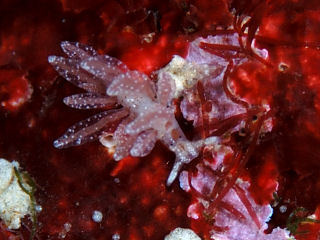
Stiliger is a genus of small and minute sacoglossan or sap-sucking sea slugs. They are marine gastropod mollusks in the family Limapontiidae.

Aeolidia papillosa, known as the common grey sea slug, is a species of nudibranch in the family Aeolidiidae.

Elysia timida is a species of sacoglossan sea slug, a marine opisthobranch gastropod mollusk. Found in the Mediterranean and nearby parts of the Atlantic, it is herbivorous, feeding on various algae in shallow water.
Alderia willowi is a species of sea slug, a marine gastropod mollusc in the family Limapontiidae. It is a sacoglossan.
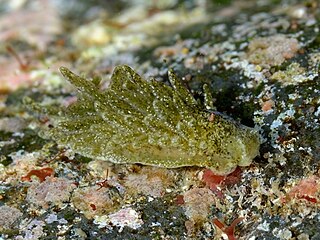
Alderia is a genus of sea slugs, marine gastropod mollusks in the family Limapontiidae. These are sacoglossan sea slugs.
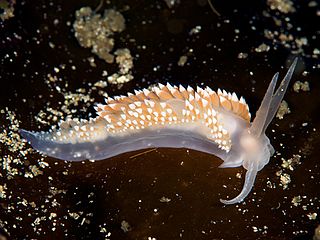
Coryphella verrucosa, is a species of sea slug, an aeolid nudibranch, a marine gastropod mollusc in the family Coryphellidae.

Scyllaea pelagica, common name the sargassum nudibranch, is a species of nudibranch, a marine gastropod mollusc in the family Scyllaeidae. This species lives among floating seaweed in the world's oceans, feeding on hydroids.

Cerberilla africana is a species of sea slug, an aeolid nudibranch, a marine heterobranch mollusc in the family Aeolidiidae.
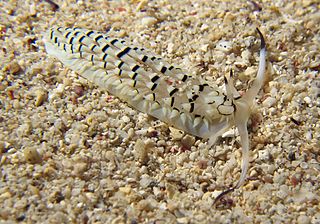
Cerberilla annulata is a species of sea slug, an aeolid nudibranch, a marine heterobranch mollusc in the family Aeolidiidae.

Cerberilla albopunctata is a species of sea slug, an aeolid nudibranch, a marine heterobranch mollusc in the family Aeolidiidae.
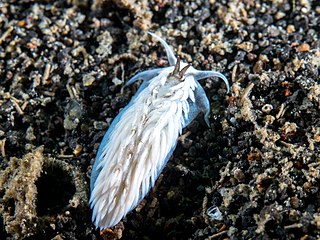
Cerberilla asamusiensis is a species of sea slug, an aeolid nudibranch, a marine heterobranch mollusc in the family Aeolidiidae.

Cerberilla ambonensis is a species of sea slug, an aeolid nudibranch, a marine heterobranch mollusc in the family Aeolidiidae.
Cerberilla bernadettae is a species of sea slug, an aeolid nudibranch, a marine heterobranch mollusc in the family Aeolidiidae.
Cerberilla chavezi is a species of sea slug, an aeolid nudibranch, a marine heterobranch mollusc in the family Aeolidiidae.

Aeolidiella alderi is a species of sea slug, an aeolid nudibranch in the family Aeolidiidae. It is native to northwestern Europe where it occurs in the intertidal zone. It is a predator and feeds on sea anemones.
Cerberilla pungoarena is a species of sea slug, an aeolid nudibranch, a marine heterobranch mollusc in the family Aeolidiidae.
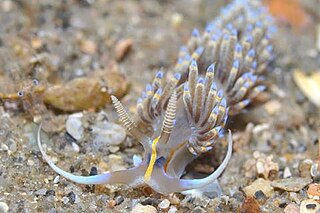
Dondice occidentalis is a species of sea slug, an aeolid nudibranch, a marine gastropod mollusk in the family Facelinidae.
Janolus flavoanulatus is a sea slug species. The specific name is derived from Latin words flavus (“yellow”) and anulatus (“ringed”). These soft-bodied mollusks are known for their extraordinary colors and prominent forms. The first description of this species was reported by researcher Terry Gosliner, a leading researcher in the evolutionary history of nudibranchs. Upon his conducted research in the Philippines, Gosliner named Janolus flavoanulatus for its yellow ring around its cerata.

Thuridilla vataae is a species of sacoglossan sea slug, a shell-less marine opisthobranch gastropod mollusc in the family Plakobranchidae. It is native to the tropical Indo-Pacific. It was first described by the French zoologist Jean Risbec in 1928; its specific name refers to the Bay of Anse Vata, just south of Nouméa, New Caledonia, where the type specimen was collected.














